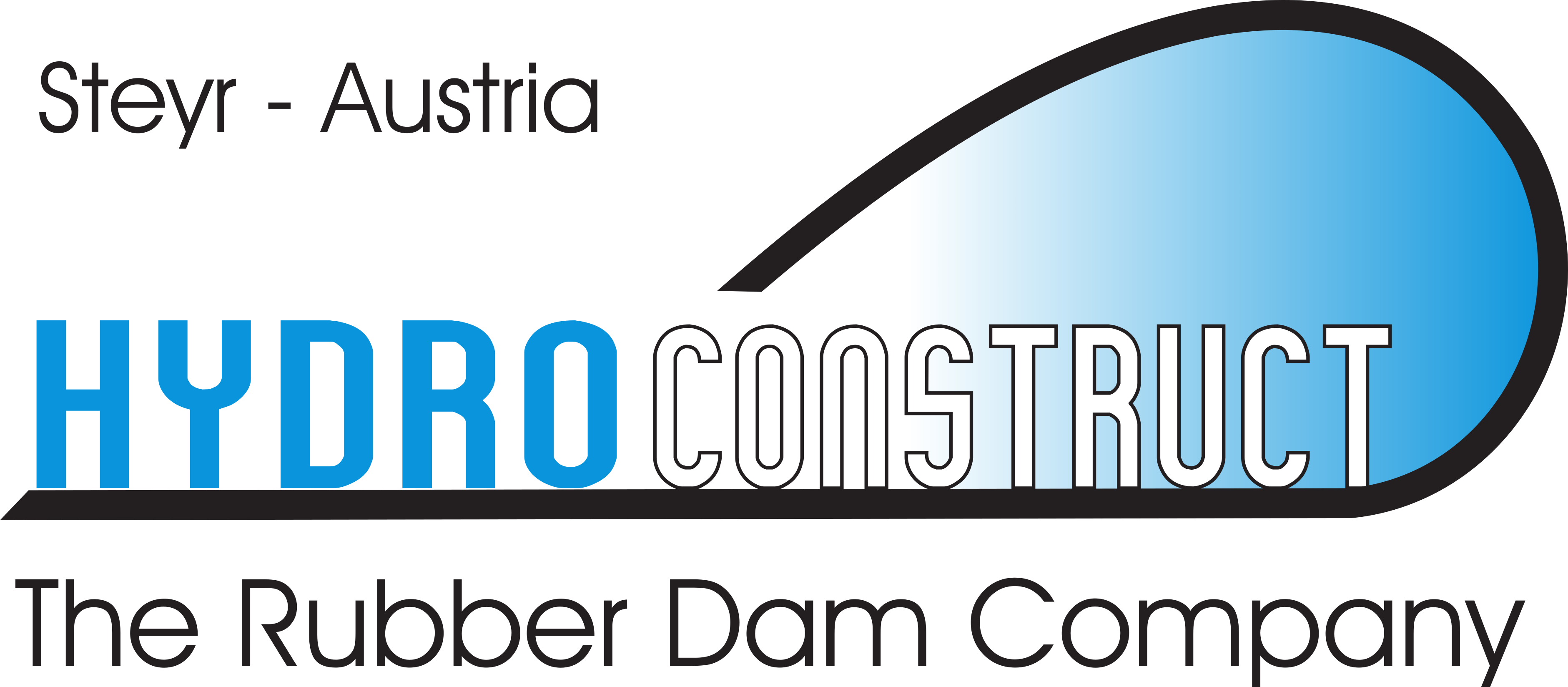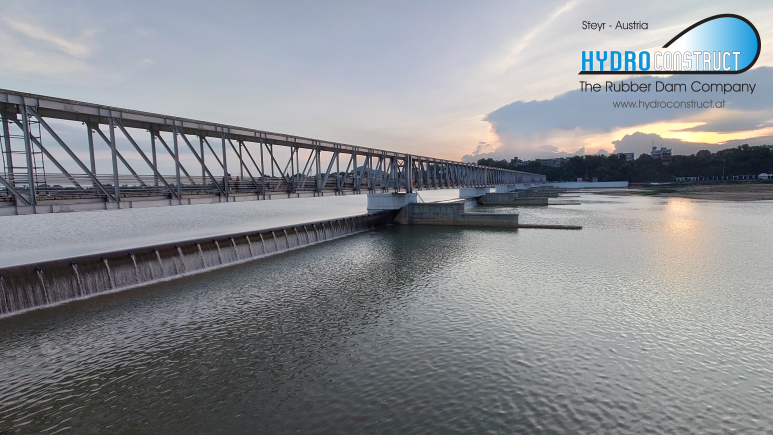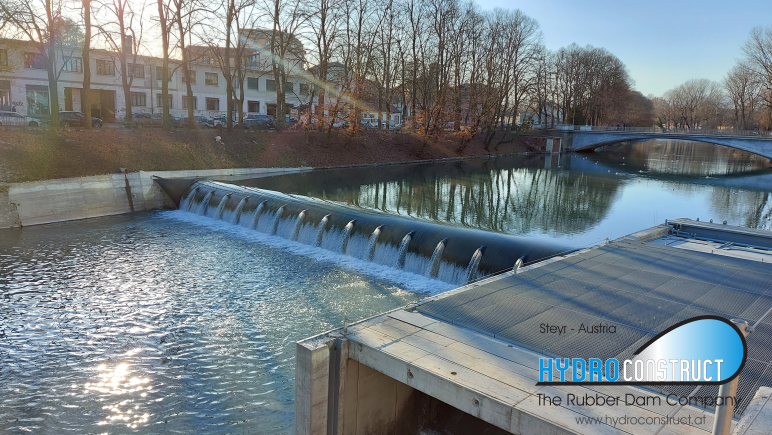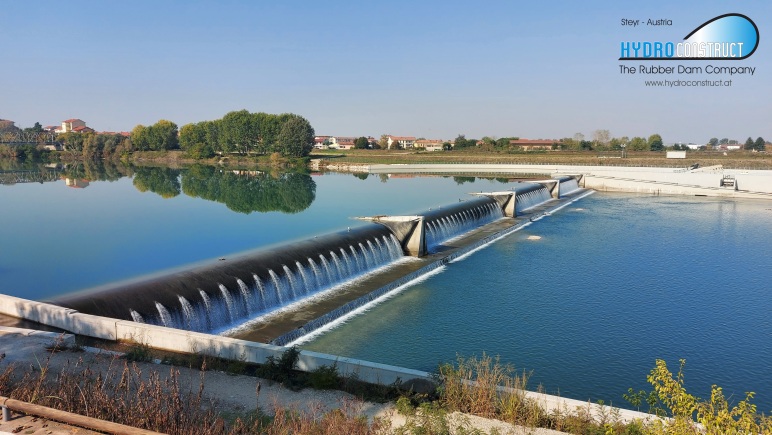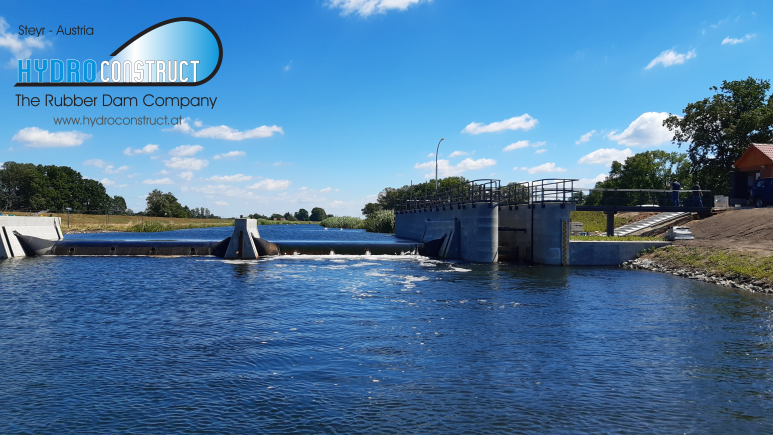Hydroconstruct rubber dams: hydropower, irrigation & river management
Hydroconstruct designs, manufactures and installs rubber dams for hydropower, irrigation and river management applications. Rubber dams or rubber gates are flexible weir structures made of inflatable rubber bladders. Thus they are the main part of the group of inflatable gates. We offer water or air filled rubber dams. The design height of Hydroconstruct rubber dams ranges from 30 cm to 4.50 m. Straight and curved weir axis designs are possible.
In principle the pressure of water or air used to inflate the rubber bladder, defines its height. The rubber bladder is formed by a rubber membrane which is directly clamped to the weir sill. Low maintenance costs are the result of this lack of moving metal parts. Our membrane is vulcanized in one piece in a continuous process.
Rubber dams can consist of multiple segments. These segments can form independent weir systems or they are linked together to act as one system.
Our rubber material and the flexibility of the rubber dam provide excellent resistance against, and easy passage of floating objects. Ice loading and freezing head ponds can be handled in a safe and controlled manner.
Water filled rubber dams
Water filled rubber dams are well suited for head water level regulation purposes. One of the use cases for a water filled rubber dam is the use in an hydropower application. In such a case the maintenance of a constant head water level is of interest for energy production at a hydropower site.
The feature of a strictly horizontal weir crest in all weir states allows a controlled lowering and rising of the rubber dam. Therefore overflow at the rubber dam can be altered from none to the maximum flow in a well defined way. The maximum flow is achieved if the rubber dam is fully deflated.
Important components of a water filled rubber dam of system Hydroconstruct are the control shaft system and of course the rubber membrane. Both are connected by concrete embedded pipe work. Thus control shafts and rubber bladder are communicating vessels and the pressure of the rubber bladder is visible in the control shaft system.
The control shaft system consists of a pump shaft, a filling shaft, a regulation shaft and a drainage shaft. If there is more the one independent weir system, for each independent system there is a filling and a regulation shaft. Pump shaft and drainage shaft can be shared between these independent systems.
Rubber dams are filled by pumping water from the pump shaft into the filling shaft. From this shaft water flows into the bladder. The rubber dam is lowered by pumping water from the regulation shaft into the drainage shaft. This causes a gradient so water flows from the bladder into the regulation shaft.
For operation in winter with temperatures below freezing point water pumping patterns ensures safe operation.
The rubber dam operation is controlled by PLC. This can either be an autonomous system or integrated in power plant control. Many systems have an independent control setup and take defined parameters and triggers from the overhead control. Important parameters are the head water level and the levels in the filling and in the regulation shaft. Besides this the position of the weir crest is also measured. For information purposes the flow over the rubber dam is calculated and displayed on the touch panel which is the human machine interface (HMI). It can also be sent along with other rubber dam parameters to the overhead control.
Air filled rubber dams
Alternatively rubber dams can be filled using pressurized air. Blowers are used for inflating the rubber bladder. Besides small differences in rubber dam design the main difference are caused by different properties of air and water. Due to the lower density of air compared to water air filled rubber dams can react faster. However there is no garantee for a strictly horizontal weir crest for all states of operation. Therefore we recommend such dams for scenarios where the dam is either fully filled, completely deflated or the continuous regulation range is smaller than full rubber dam height.
Air filled rubber dams are regulated by various flap valves embeded in the control pipe system located in a nearby control room. This system consists of actuator operated flap valves for filling and deflation procedures. Additionally there are manual flap valves as backup. Weirs consisting of multiple weir spans can have such control system for each span for independent operation.
For security there are six pressure limiting or releasing devices installed. On the one hand these protect the rubber dam from over pressure and on the other hand they allow a safe and independent deflation of the rubber dam in case of power loss and hight flow rates in the river.
Internationally successful
Hydroconstruct is based in Steyr, Austria. From the beginning in the late 1970ies projects in Germany, Italy, Switzerland, Norway, Albania and France helped to gain international experience. A major step for Hydroconstuct was to expand its activities to India. The success of this step resulted in the foundation of an Indian branch of Hydroconstruct.
For the future Hydroconstruct plans to get a foothold in northern and southern america. Therefore we are open for partnerships with companies based in Canada and the United States of America. Our interest would also be in an operative cooperation and we are willing to sell company shares to our new partners. So we both make best use of the synergies of such a partnership.
Conclusion
Hydroconstruct rubber dams are very versatile dam structures. If you have further questions or need more details, please feel free to contact us. Also if you have a specific project and you want our opinion on the applicability of a rubber dam, you are wellcome to write a note. Last but not least we would be happy to submit a quotation for your future rubber dam.

